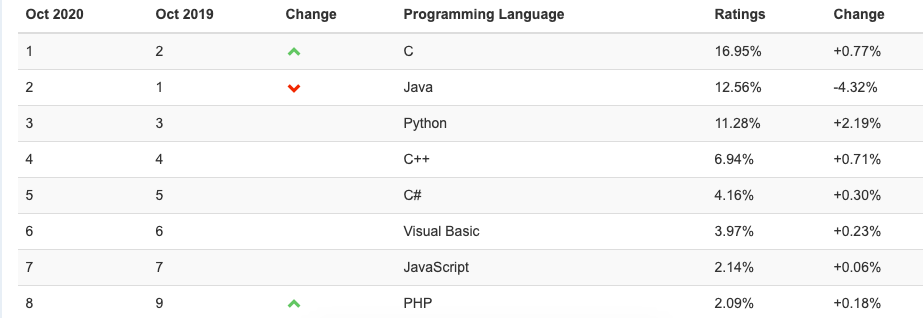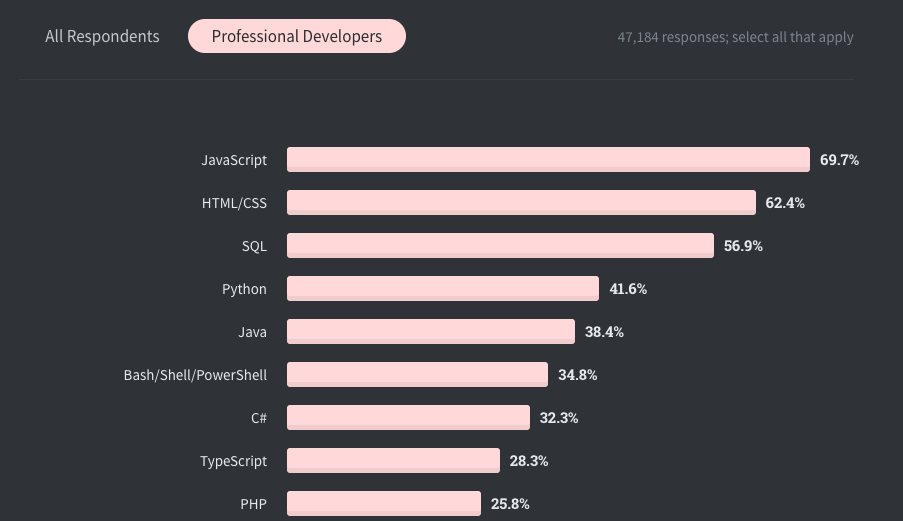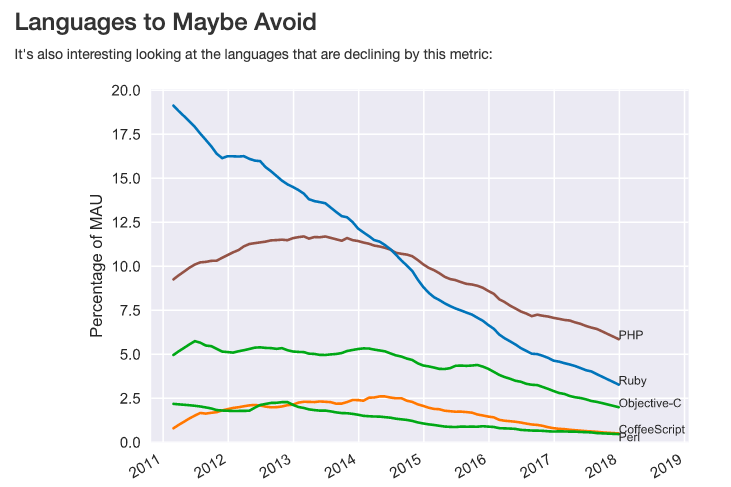Python and PHP are both object-oriented and interpreted languages that can run on a variety of operating systems and environments. Both languages are dynamically typed and boast impressive IDE (integrated development environment) support. Both PHP and Python also stand out when it comes to their syntax, as they are much different to C-style languages. PHP is a champion of web development - it is estimated that as much as 80% of all websites use some version of the language.
However, its web-based beginnings make it a difficult tool to use in general programming - it requires complex structures and extensions. Python on the other hand has been recently gaining traction in the web-based world and as many fintech companies are becoming fond of the language it is gearing up to take over some of PHP’s market share in that department.
Both languages have their vocal supporters and both are also quite different. If you’re wondering what would be better for your web project - the ubiquitous but slightly outdated PHP or a relatively new coming (in this area) Python, don’t worry. Below we discuss all of the most important aspects of each language and suggest which one will satisfy your software needs best! Behold, Python vs. PHP: the final throw down.
PHP vs. Python: in numbers
TIOBE Index
The TIOBE Programming Community index is an indicator of the popularity of programming languages compiled monthly and based on the number of skilled engineers world-wide, courses and third party vendors using a given language. You can read more about the index and the organization at: tiobe.com

Python reigns supreme here, with almost 10 p.p. higher usage rating (and rising!) than PHP, placing third overall. TIOBE indices over the years indicate, while PHP has lost its initial popularity and remains strongly in the bottom of the top 10, Python has had an impressive rise over the years, especially in the early 2000s. It is now a far more popular programming language than PHP according to TIOBE, and the upward trend indicates this difference will only deepen.


*Python has been TOBIE’s language of the year three times since the ranking started in 2003, and was most recently crowned in 2018. PHP has been language of the year only once, back in 2004.
Stack Overflow
Stack Overflow’s 2020 was the 9th consecutive year for the survey with 90,000 developers responding. More information on SO’s website.


Python has almost double the popularity PHP does when it comes to Stock Overflow’s respondents. PHP is used by slightly more than a quarter of professional (and otherwise) developers. Python on the other hand has surpassed 40% and is continuously rising in popularity.
GitHub users
GitHub is one of the world’s largest code development platforms. It is the largest host of source code in the world with more than 40 million users and over 100 million repositories (including at least 28 million public repositories). Ben Frederickson used GitHub’s archives to track programming languages its users write code in. Every user interaction with a repository is counted as using the language of that repository. The aggregated number gives the Monthly Active Users (MAU) each language has. More info on methodology and sources: https://www.benfrederickson.com/ranking-programming-languages-by-github-users/


Python is a clear champion amongst GitHub users. What’s more, because of its downward trend, Bren Frederickson classified PHP as a language to maybe avoid. He does explain however that this decline in popularity may be because of the influx of the new MAUs which are the basis of this metric.

Other rankings comparing Python vs. PHP in numbers
- Number of pull requests in a given language is used to rank programming languages in GitHub Octoverse
- How likely programmers are to switch a language was measured using blog posts discussing moving from one language to another in order to rank programming languages by Erik Bernhardsson
- Number of people transitioning languages on GitHub was used by the team at sourced
Python vs. PHP from the managerial perspective
Project managers and CTOs use different criteria when assessing the usability of a programming language compared to learners, developers, and engineers. We delve into some of the most important aspects of software development from a managerial and institutional perspective below to see whether Python or PHP are a better choice for your team.
Python vs. PHP: Developer productivity
- Points for Python
- Python is known for being concise and readable, allowing for fewer lines for code than PHP to perform similar tasks. Because of its simple and readable syntax, to add a certain functionality, you need to code 100 lines in Python or around 600 lines in PHP.
- Because of its development time efficiency, Python is preferred when releasing an app under the Minimum Viable Product (MVP) model or building and testing prototypes, even if the final product is to be written in a different language.
- Points for PHP
- PHP is a built-in language for many web interfaces (and every web hosting service), which may be very efficient for quick and small web-based projects
PHP vs. Python: Content management
- Points for PHP
- PHP lies at the core of several content management systems such as Wordpress, Drupal, or Joomla. Its track record powering all the websites built on those systems makes it proven for content management.
- Points for Python
- Python-based applications, although still not vastly popular in the larger market of CMSs, have several inherent advantages. For instance, Python's Unicode capabilities make its derived products particularly popular in continental Europe and Asia (as compared to those based on PHP).
Scalability and flexibility
- Points for Python
- Applications built on Django (the Python framework) offer high artificial intelligence and machine learning capabilities, which leads to relatively high scalability and easy adaption to evolving trends.
- Django constitutes a series of wired-up and ready-to-go components that are decoupled, which allows for unplugging and replacement when the demands of a given project change.
- Issues with PHP
- PHP is less open to new trends and growing demands; it is far less flexible with massive projects and offers limited scalability in comparison.
PHP vs. Python: Speed
- Points for PHP
- PHP 7.x is extremely fast, almost 3x faster than a typical Python-based program. However, previous iterations of language are much slower.
Environments of operation
- Points for PHP
- PHP is hugely popular on the server-side of the web, because of its pioneering position in the web server development technologies. Most web hosting servers have PHP installed.
- PHP runs on diverse platforms such as Windows, Unix, Linux, Solaris or Mac OS X.
- Issues with Python
- Python’s interpreted nature allows delivering applications through different platforms, which makes Python a language suitable for general development. However, it pales slightly in comparison to PHP as it is compatible only with operating systems supporting high-level languages.
- It also doesn’t support mobile development.
Python vs. PHP: Cost
- Points for PHP
- Because of the high supply of experienced PHP developers and greater number of resources available, programmers using PHP tend to have lower remuneration rates.
- PHP also has cheaper hosting options available, which means its overall development and maintenance costs can be lower than those of a Python-based project.
- Points for Python
- Because of greater flexibility and scalability of Python projects, although they have higher initial costs, they can be adapted with less person-hours.
Popularity
- Points for PHP
- If you want to cater to web-based clients, most of them will be accustomed to working with PHP. Amongst biggest PHP-based engines of platforms are: Wordpress, Facebook, Flickr, Slack, 9gag, Typeform, MIT, Wikipedia or Lyft.
- What’s more, PHP is used by over 43,000 other companies, according to Stackshare
- Points for Python
- Although only around 6,800 companies reportedly use Python in their tech stacks, these include huge players such as Google, Uber, or Pinterest.
Python vs. PHP from developer perspective
Developers focus on different features when looking for a language to learn and develop in
Entry point and learning curve
- Points for Python
- Python has a relatively low entry point and it is easy to grasp the basics of writing code in Python.
- Points for PHP
- It is relatively easy to get started with PHP, especially for simple web projects.
- Issues with PHP
- Because it was not originally meant as a general-purpose language, it is more difficult to write complex code with it.
Debugging
- Points for Python
- Python’s debugger surpasses PHP debugging package (XDebug) in terms of usability, as it requires less tools. It’s well-documented and very easy to use, saving person-hours, and in turn lowering costs.
Database connectivity
- Points for PHP
- PHP has over 20 databases available, and is compatible with Oracle, MySQL amongst them.
- Issues with Python
- Python doesn’t support database connectivity as well as PHP.
Security
- Points for Python
- Python is popular with cybersecurity professionals for backend development. Reportedly, CIA, US Department of Education, US Department of the Navy, and US National Institute of Standards and Technology (NIST) all use Python as their backend language.
- What’s more, Django comes with built-in security features.
- Issues with PHP
- PHP has had a bad track record with security, and is considered somewhat vulnerable. However, thanks to huge community support, many security issues are being resolved rapidly.
Because both Python and PHP are open-source, they boast huge and very active communities which contribute to the languages themselves constantly and offer support for newcomers and experienced users alike. PHP has a famously big community which adds greatly to the language; some critics have argued that it’s too large. Python’s community is constantly growing and seems to be more diverse in terms of background (in coding as well).
Python vs. PHP: summary
Apart from versatility (where Python truly is a general purpose programming language and PHP a web “lingua franca”), the main difference between PHP and Python may be their long-run potential. PHP is quite clearly becoming a legacy language, whose users will mainly maintain the existing systems. Python on the other hand is booming, and if this trend continues, will become a better tool for developing new applications (for the web as well) than its competitor. As far as comparing PHP with Python in terms of usability, if the project is relatively simple, web-based, and associated code is already in PHP, it may be worth sticking to the web development classic whose 7th version is superbly fast. However, if your project is more complex, potentially innovative and requires reliable, secure and clear code, Python is a clear favourite.
Python vs. PHP: differences and uses
| | Python | PHP |
| Good for | Statistics, analyticsLow budget projectsTight deadline projectsMachine learningfintech | Web development. By estimates used by over 70% of websites and works great with “traditional” web features: content, social platforms, blogs;Anything that requires compatibility with Apaches, IIS servers;Maintaining legacy software; |
| Bad for | Data processing—it is not designed to perform well in highly specialized apps for data processingMobile development | Robust programsPretty much anything that is not web-based |






